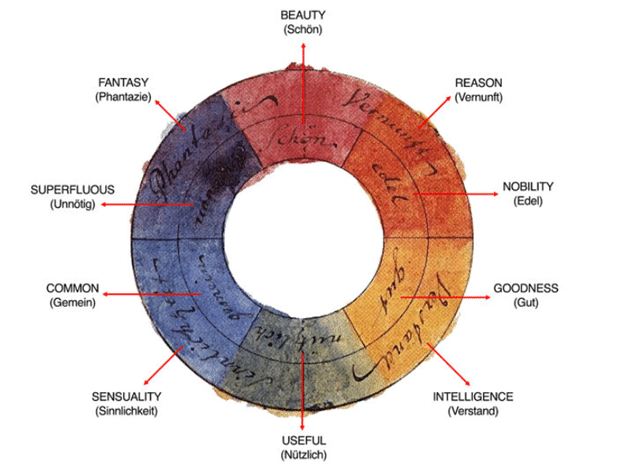ARE SIMILARITIES ASSOCIATING COLOURS AND EMOTIONS COINCIDENTAL OR UNIVERSAL AND SUBCONSCIOUS?
Previous posts in this series have shown how similar colours are used to represent the same emotions.
- Emojis use yellow to represent happy feelings and blue is associated with sadness.
- The Atlas of Emotions uses 5 colours: enjoyment is yellow/orange, sadness is blue, disgust is green, fear is purple and anger is red.
Are the same emotional colour choices coincidental?

The movie Inside Out uses the same colours as the Atlas of Emotions.
In an interview the film director explained his colour choices:
- Joy was a golden star but yellow is easier to create digitally
- Blue teardrops represented sadness
- He perceived fear as a purple raw nerve
- Angry people turn red in the face
- Brocolli is green and disgusting


Other examples of colour symbology include:
- Purple – associated with royalty because the dye was expensive and hard to obtain.
- In China, red is a lucky colour but is linked to communist brutality in Russia
Colour Theory and Emotions
In Germany in the early 1800s, Goethe instinctively associated colours with characteristics and feelings on this colour wheel.

Translation of the Color Circle of J.W.V. Goethe, 1810
This Colour Theory table was developed in the 1930s by the Russian artist Kandinsky, a member of the German Bauhaus Group, linking colours with music and emotions.

Modern colour/emotion associations are very different from those suggested by Goethe and Kandinsky perhaps because there are differences in culture and eras.
Any similarity linking colours with emotions in the Atlas of Emotions, emojis and Inside Out seem coincidental maybe down to conscious Colour Symbology.
Designing for a universal emotional response to colours means that we must all perceive the same thing when we look at it.
READ MY NEXT POST TO UNDERSTAND THE SCIENCE BEHIND HOW WE “SEE”
Emoji – A small image used to communicate information without using words
Personified – representing something which is not a person in human form
Colour Symbology describes when association are dependent on culture, age or gender.
Eras – periods in time
Contentserver.com.au. (2015). [online] Available at: https://contentserver.com.au/assets/497342_p10840532_p_v7_af.jpg [Accessed 4 Dec. 2019].
Paul Ekman Group. (2015). The Science of Inside Out | How Emotions Work | Paul Ekman Group. [online] Available at: https://www.paulekman.com/blog/the-science-of-inside-out/ [Accessed 19 Dec. 2019].
Movies & TV Stack Exchange. (2015). Why are the emotions colored in the way they are?. [online] Available at: https://movies.stackexchange.com/questions/42672/why-are-the-emotions-colored-in-the-way-they-are [Accessed 13 Dec. 2019].
Ede & Ravenscroft. (2020). Royal Robes. [online] Available at: https://www.edeandravenscroft.com/ceremonial-dress/royal-robes/ [Accessed 13 Dec. 2019].
The Shutterstock Blog. (2015). Symbolism Of Colors and Color Meanings Around The World. [online] Available at: https://www.shutterstock.com/blog/color-symbolism-and-meanings-around-the-world [Accessed 19 Jan. 2020].
Ivanovic, I. (2019). Symbolic Color Associations in Goethe’s Farbenlehre and its Application in the Pictorial Work of its Early Receptors. [online] (PDF) Symbolic Color Associations in Goethe’s Farbenlehre and its Application in the Pictorial Work of its Early Receptors. Available at: https://www.researchgate.net/publication/331043528_Symbolic_Color_Associations_in_Goethe%27s_Farbenlehre_and_its_Application_in_the_Pictorial_Work_of_its_Early_Receptors/figures?lo=1 [Accessed 18 Dec. 2019].
Google.com. (2020). Color Theory according to Wassily Kandinsky: “Concerning the Spiritual in Art”. [online] Available at: https://www.google.com/url?sa=t&rct=j&q=&esrc=s&source=web&cd=31&ved=2ahUKEwiFpeCepvbkAhWEzKQKHRdHB3sQFjAeegQICBAC&url=https%3A%2F%2Fwww.mat.ucsb.edu%2F~g.legrady%2Facademic%2Fcourses%2F12w259%2FKandinsky_%2520Color%2520Theory.pdf&usg=AOvVaw1nPqT73HB45y1pcGPint4F [Accessed 15 Dec. 2019].
